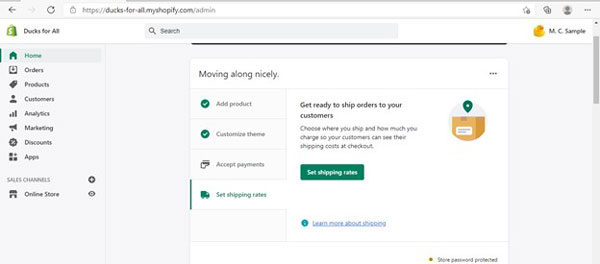Best Website Builder for Subscription Box Businesses in 2025
Building a website is a necessary step in selling your goods online. Your ecommerce site is the virtual home of your business, where you can showcase products and interact with customers.
Since you’re building a website to sell subscription boxes, your needs will differ slightly from other ecommerce sites. This guide will help you find the best website builder for subscription box businesses currently available and give additional recommendations to help you create the best website for your business.
Make sure you have everything you need to get started. Check out our Best Website Builder Review and How to Make a Website guides to get started on the right foot!

Best Website Builder for Subscription Box Businesses: Our Recommendation
Our #1 recommended website builder for subscription box businesses is Shopify. Its featured collections tool makes it easy to highlight your top sellers or new items, and the Shopify Website Builder makes it easy to add products, edit pages, and add anything your online store might need to thrive.
Shopify
Best overall subscription box website builder:
- Best Theme Designs
- Featured Collections
- Sell on Social Platforms
- Free Trial Available
Using the Shopify Website Builder for Subscription Box Websites
People love subscription boxes, but, before they’ll purchase one from you, they’ll likely want to use your website to gather information. As such, you should establish some basic objectives of what you want your site to do for you. This may include:
- Showcasing your available items so people decide to buy them.
- Providing shipping solutions that work for your customers.
- Creating an online home for new customers to find your business.
The Shopify Website Builder provides many tools you can use to create a website that’ll suit the individual needs of your subscription box business. You can pick and choose from dozens of layouts and styles to meet your needs.
That may sound overwhelming, but it really doesn’t have to be. In fact, none of these tools require any type of coding so it’s super easy to set up your website and use it as you’d like.
Versatility like this — along with an efficient and easy-to-navigate online store — can help your business website better suit the needs of your customers and your business.
One of the best ways to show customers what you offer is to use Shopify’s product listing tool. It’ll enable you to upload your subscription box options to your website in just a few minutes. You can choose from several layouts while also creating a customized gallery to highlight everything included in each of your subscription boxes.
Here’s a screenshot of this tool in action to show you just how easy it is to upload product photos to a Shopify website:

It’ll really only take a few clicks to set up your subscription boxes. You can then come back and change them, as needed.
Another important feature for most subscription box websites is to offer visitors payment and shipping options that work for them. While this can be a tedious part of any website build, the Shopify Website Builder really makes it easy.
Here’s a look at how this works in the Shopify platform:

What’s nice about this is that you can have the Shopify platform do just about everything for you. That includes shopping for shipping carriers and even printing shipping labels. It’s pretty efficient and can definitely improve your business operations.
As you work to build your subscription box business, you’ll likely also need to use some of the other features on the Shopify platform like its social media, email newsletter, and photo tools. With no coding or formatting to worry about, it’s easy to see just how much control over your website you can have with Shopify. There’s a reason why we rate it the best for ecommerce.
Getting Started With Shopify
One of the other major benefits of the Shopify Website Builder is the ease of getting started. All you have to do to begin your free trial is enter in your email, a password, and the name of your shop. Shopify will then ask you a quick series of questions to better customize your shop theme. Fill out the sections accordingly and select “Other” for the industry you operate in.

Once you click “Enter my store,” you’ll be taken to your Shopify dashboard, where you can begin creating your online shop.
Shopify’s builder uses your answers to better understand your business name and type so as to construct a theme that’ll best suit your business.
Once here, you can begin to customize the theme to match your branding or choose a new one entirely. There are ways to begin adding products, connecting to social media to sell on other platforms, and even ways to collect customer emails for future alerts and sales campaigns.
Depending on the level of customization that you would like to do, you can continue to add, change, and move things around until you have your dream website!
Cons of the Shopify Website Builder for Subscription Box Websites
While this website builder is our recommended pick for subscription box businesses, it’s not totally flawless. There are a few things that may push certain users to other builders. These cons include:
- It Lacks Payment Flexibility — One of the biggest limitations when it comes to selling subscriptions on the Shopify platform is that you must use the Shopify Payments system. Shopify won’t allow you to accept any other payment methods, such as Apple Pay or PayPal, for this type of product. If you want to do that, consider using an alternative website builder.
- It’s Ideal for Ecommerce, But Costly for Sites With Other Goals — Shopify provides one of the best ecommerce website builders. But, it may not be the best fit if you don’t plan to sell much on your website and instead want it to focus on educating customers about your subscription boxes. The Shopify platform is still versatile and flexible, but its cost may seem expensive if you don’t need an ecommerce-based website.
Shopify Website Builder Summary
Overall, the Shopify Website Builder is our top recommendation for subscription box businesses selling online. The pros outweigh the cons by a landslide.
Check out the Shopify Website Builder for yourself and start your free trial!
For more information on the Shopify Website Builder, check out these articles:
- Shopify Website Builder Review
- How to Make a Shopify Website
- How to Use the Shopify Website Builder
- Shopify Website Builder Pricing and Plans
- Shopify Website Examples
Web.com
Like most website builders nowadays, Web.com enables users to quickly create a functional website without needing to write a single line of code. It also includes an extremely affordable signup offer for the first month, which allows for time to learn the platform before having to truly pay for it. As one of the first website builders available on the internet, it has also perfected the art of drag-and-drop functionality and includes fast uptimes, allowing your site to be better optimized for search engines.
The problem is that Web.com hasn’t entirely updated with the times. Its templates feel a bit outdated, and there are moments when using the editing tool feels a little less intuitive than it does on more modern platforms like GoDaddy, Wix, or Squarespace. Additionally, despite the low cost of premium plans at signup, these prices skyrocket after the first monthly billing cycle. This may make it seem like an affordable option, but in practice that might not shake out to be true.
To learn more about the pros and cons of Web.com, read our Web.com Website Builder Review.
Web.com
Optional subscription box website builder:
- Easy to Use
- Unlimited Storage
- SEO and Blogging Tools
- Signup Offer
WordPress
WordPress is one of the most popular website builders on the market, and with good reason. This content management system (CMS) is highly customizable, endlessly flexible, and can be one of the least expensive options available to small business owners. WordPress consistently ranks as one of the best website builders in the world, and it can be a good choice for your business website.
However, WordPress does have its drawbacks. Site owners must purchase their own domain name and hosting package, and they also have to perform routine maintenance tasks like updating their website and plugins and conducting site backups. In addition, WordPress is not an easy-to-use builder, especially when compared to other recommended options like GoDaddy, Wix, or Web.com. Typically, we only recommend WordPress to business owners who already have experience with the builder or are more tech-savvy.
To learn more about the pros and cons of WordPress, read our WordPress Website Builder Review.
WordPress
Optional subscription box website builder:
- Highly Customizable
- Unlimited Storage
- Popular
- Inexpensive
Wix
Wix consistently ranks high in our list of best website builders, and it’s easy to see why. Having been around for a while, Wix has updated well with the times and remains a very sleek, modern platform where users can create a high-performance website without having to spend too much time learning about web design. Its templates feature beautiful designs, and there are many customization options available — as well as a (very limited) free plan for users looking to save some money.
Despite all of this, some of these added features come with an extra layer of complexity. Using Wix’s editor is simply not as easy and intuitive as some of its competitors. Wix also lags behind when it comes to analytics and other basic metrics a small business owner will need to keep track of growth. Finally, despite offering a free plan, there are a lot of features missing from it — like a Wix subdomain — and Wix premium plans run a bit steeper than the likes of GoDaddy and Web.com.
To learn more about the pros and cons of Wix, read our Wix Website Builder Review.
Wix
Optional subscription box website builder:
- Modern Templates
- Unlimited Storage
- Popular
- Free Plan Available
How to Choose a Website Builder for Subscription Box Businesses
Choosing a website builder is one of the most important decisions you will make when it comes to building your online store and website for your subscription boxes. If none of the suggestions above seem like they will fit your needs, then you’ll need to select a different builder. This section will give you a framework to make the decision in the most effective way possible.
Once you have an idea and guidelines of how you will make this choice, check out our Best Website Builder of 2025 review for several different options and reviews of each builder.
Ease of Use
The most important factor when choosing a website builder is its ease of use. It doesn’t matter how many bells and whistles or beautiful templates the builder has if you can’t figure out how to use it.
Of course, all builders will have a learning curve. But, some are just considerably simpler than others. WordPress, for example, is an absolutely amazing tool that gives you almost limitless flexibility but is one of the least intuitive builders on the market.
Most small businesses that use WordPress end up hiring developers and marketers to create and manage their websites. This is not a bad thing, per se, but it’s a decision you will have to make. After all, you know your business and its needs best.
Speed of Implementation
Similar to ease of use, speed of implementation is an important factor when starting a new site from scratch. When beginning a new business, you will have a massive number of tasks that need to be taken care of in order to get things going. Creating a website is absolutely one of the most important.
With this being said, it obviously makes more sense to use a tool that can have you up and running quickly. Some builders are better suited than others when it comes to a new site.
Some give you a blank slate to work from, others give you templates, and others still use AI to understand your unique needs and help to fill in some of the blanks for you. The right answer for you may be different than for someone else, but understanding this will give you a massive advantage when selecting your builder.
Expandability
Expandability is less about what you want to do with your website now and more about what your long-term ambitions are.
For example, let’s say that you are starting a basic website that helps your customers find where your business is and gives them multiple ways to contact you. Two years from now, you know that you want to have a full-blown software-as-a-service (SaaS) app on your website. There’s a good chance that the tools you need are going to be very different between now and then.
Something to note is that using one system doesn’t mean that you can never change platforms. That being said, migrating a site from one tool to another is usually a pretty in-depth undertaking and at least a medium-sized headache.
In the beginning, try to look forward and plan into the future for what your needs will be at different stages of your business. This will give you the insight you need to make the best decisions possible.
Additional Factors
Along with the three that we have mentioned, there are other factors that may guide your choice of website builder:
- Price — Naturally, price is a factor when choosing a website tool. If you’re starting a small blog, there’s no reason that you would need a major ecommerce suite. Keep in mind, however, that your business will be supporting this website, and hopefully, your revenue will make these $10 to $30 per month expenses look like a drop in the bucket.
- Templates and Themes — Good web design can be tricky. Do you know exactly what should go on your homepage? Having a large library of templates gives you a running start when it comes to designing the pages that will make up your website.
- Responsive Design — For the most part, all builders nowadays should have this figured out for you, but keep in mind that if your website doesn’t look good on all screen sizes (e.g., mobile, desktop, tablet, etc.), you’ll alienate a large number of your customers. Have you ever backed out of a website because it looked terrible on your phone? That is what you want to avoid for your own website.
Final Thoughts
Based on the specific needs of a subscription box business, the Shopify Website Builder is a solid choice overall. It’s flexible enough for most types of subscription businesses, and it’ll enable you to load products to your site quickly and easily. Moreover, the Shopify platform makes it efficient to set up your shipping options and manage customer payments.
Check out our full Shopify Website Builder Review for more details and our Best Website Builder of 2025 guide to see how it stacks up against the other builders.


